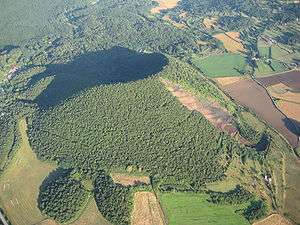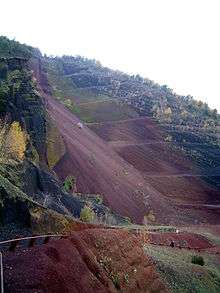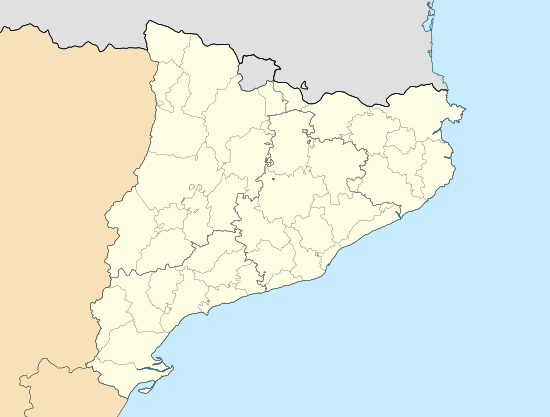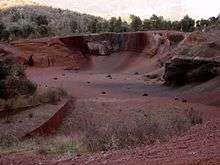Croscat
The Croscat (Catalan pronunciation: [kɾusˈkat]) is a volcano in the comarca of Garrotxa, Catalonia, Spain. It is both the youngest and highest volcano in the Iberian Peninsula, with the last eruption dated back to about 14,000 years Before Present.[3] The volcanic cone has a horseshoe shape, and its northeastern flank was quarried for volcanic gravel until the early 1990s, exposing the internal structure of the cone from top to bottom. The volcano is located in the Garrotxa volcanic field, a Quaternary volcanic field also known as Olot volcanic field, as part of the protected area of the Garrotxa Volcanic Zone Natural Park.[1][4][5]
| Croscat | |
|---|---|
 Aerial view of the Croscat volcano | |
| Highest point | |
| Elevation | 786 m (2,579 ft) [1] |
| Coordinates | 42°9′15″N 2°32′9″E |
| Geography | |
| Parent range | Catalan Transversal Range |
| Geology | |
| Volcanic arc/belt | Garrotxa Volcanic Field |
| Last eruption | 11,500 years ago[2][Note 1] |
Geology
The cone has a height of 189.04 metres (620.2 ft)[Note 2] and an elliptical base with a horseshoe shape, probably caused by the breaching of the western-side of the volcano as a result of the effusion of lava flows during the last eruptive phase of Croscat.[6][7][8]
A study published in 2011 at the Journal of Volcanology and Geothermal Research revealed that the Santa Margarida Volcano and the Croscat were the product of the same eruption event 11,500 years ago, alternating phreatomagmatic activity, between water and magma, and magmatic activity.[2][6]

Human history
Starting from the 1960s, the northeastern flank of the volcano was quarried for lapilli gravel.[8] The extraction of material from the volcano cone and the degradation of the volcanoes of the Garrotxa Volcanic Field sparked a series of protests in the 1970s to protect the volcanic field, a campaign that came to be known as Save the Volcanoes (Catalan: Salvem els Volcans).[9] The extraction area was also used as an uncontrolled municipal landfill for the city of Olot. In 1982 the Garrotxa Volcanic Zone Natural Park was created to protect the area but the extraction lasted for another nine years. Further protests were sparked after an agreement was reached between the concessionaire of the quarry, Minas de Olot, SA, and the Generalitat of Catalonia for the further extraction of 2.7 million tons with educational and scientific purposes, with the commitment of restoration of all excavated areas. The successive non-fulfillment of the restoration program resulted in the issue of at least ten disciplinary proceedings in the subsequent years.[8] The mining operations were stopped in 1991, when the Generalitat of Catalonia acquired the majority of shares of the mining company.[10]
The extraction left a vent 100 metres (330 ft) high and 400 metres (1,300 ft) long covering around 40 degrees.[1] This section allows the observation of the internal structure of the cone as if the volcano was part of a real cutaway drawing.[4] In the 1990s a territorial landscaping project was undertaken to restore the extraction site and the landfill to recover the morphology of the base of the volcano and the pastures surrounding the area. The project, which won an award for landscape design, minimized the landscape impact, prevented erosion and planned public access for educational purposes.[10] [11]
Gallery
See also
Notes
- Its last eruption is estimated to have occurred around 11,500 or 11,000 years ago depending on the source.
- The height of the cone is given as 156 metres (512 ft), 160 metres (520 ft) or 189.04 metres (620.2 ft) depending on the source.
References
- Mallarach, Josep Maria (4 May 1991). "Croscat, el gigante de los volcanes" [Croscat, the giant of the volcanoes]. La Vanguardia (in Spanish). Retrieved 18 March 2012.
- "Descubren que volcanes Croscat y Santa Margarida los formó la misma erupción" [They discover that the Croscat and Santa Margarida volcanoes were formed by the same eruption]. EFE (in Spanish). abc.es. 27 January 2011. Archived from the original on 14 July 2014. Retrieved 18 March 2012.
- Sana, Maria. "14C dating of the last Croscat volcano eruption (Garrotxa Region, NE Iberian Peninsula) | Maria Sana". Academia.edu. Retrieved 2013-08-31.
- Purves, Libby (29 April 2002). "A walk through the thunder mountains". Daily Mail. Retrieved 18 March 2012.
- "Geozona 210 Volcans Santa Margarida, Croscat i Rocanegra" [Geozone 210 Santa Margarida, Croscat and Rocanegra volcanoes] (PDF). Departament de Medi Ambient i Habitatge - Direcció General del Medi Natural (in Catalan). gencat.cat. Archived from the original (PDF) on 13 April 2012. Retrieved 28 March 2012.
- Martí, J.; Planagumà, L.; Geyer, A.; Canal, E.; Pedrazzi, D. (2011). "Complex interaction between Strombolian and phreatomagmatic eruptions in the Quaternary monogenetic volcanism of the Catalan Volcanic Zone (NE of Spain)". Journal of Volcanology and Geothermal Research. 201: 178. doi:10.1016/j.jvolgeores.2010.12.009.
- Di Traglia, F.; Cimarelli, C.; De Rita, D.; Gimeno Torrente, D. (2009). "Changing eruptive styles in basaltic explosive volcanism: Examples from Croscat complex scoria cone, Garrotxa Volcanic Field (NE Iberian Peninsula)". Journal of Volcanology and Geothermal Research. 180 (2–4): 89. doi:10.1016/j.jvolgeores.2008.10.020.
- "Máster en Espacios Naturales Protegidos" [Master in Protected Areas] (PDF) (in Spanish). Generalitat de Catalunya. 2010. Archived from the original (PDF) on 13 April 2012. Retrieved 18 March 2012. Cite journal requires
|journal=(help) - Bassols, Emili (2007). "Parc Natural de la Zona Volcànica de la Garrotxa. 25 anys de gestió del territori" [Garrotxa Volcanic Zone Natural Park. 25 years of land management.] (PDF). Annals del Patronat d'Estudis Històrics d'Olot i Comarca (in Catalan) (18): 189–245. Archived from the original (PDF) on 13 April 2012. Retrieved 18 March 2012.
- Bassols, Emili (2008). "Els volcans salvats" [The volcanoes saved] (PDF). Revista de Girona (in Catalan) (251): 60–65. Retrieved 18 March 2012.
- "10. Croscat Natural Reserve". Generalitat de Catalunya. gencat.cat. 9 April 2012. Retrieved 18 March 2012.
External links
| Wikimedia Commons has media related to Croscat Volcano. |



